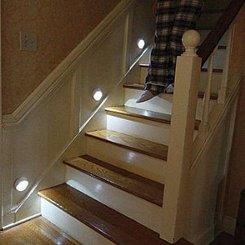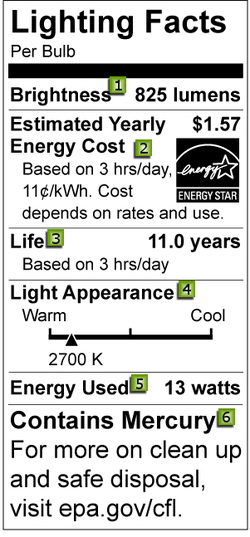It is often difficult to effectively light a kitchen. Traditional methods of lighting use recessed lights, or hanging fixtures. These
methods require more power consumption and light output to illuminate countertop workspace. Many times you can't help but block the light as you are working and upper wall cabinets tend to shade a generous portion of your countertop. There is a very simple solution to this inconvenience that seems to annoy us as we work in the kitchen. The solution is this: Place the light source in front of you and under the cabinets! Under cabinet lighting can come in a variety sources. There are three types of low voltage lighting that range in complexity, price, and function. Each type is a sleek, energy efficient method of lighting the countertop space in your kitchen using LED's.
Battery Operated LED Spotlights
The most budget friendly method of lighting under cabinet work space is battery operated LED spot lights. These individual lights come in packs of pod lights or in track light assemblies and can me mounted directly underneath your cabinet and spaced out as desired. A benefit to this option is that they can be installed cleanly and simply without wiring.
Battery operated under cabinet lighting can either be switched on or off at the source or many times are capable of turning on or off automatically. The
Slyvania Golden Dragon kit can be switch to an automatic mode controlled by
motion sensor. Using the energy efficient occupancy sensor switch function you will never have to remember to turn the lights off! Other products such as the
Lumen LED High Output Spotlights come with a remote control that eliminates the need to reach under the cabinet to find the switch.
If you are concerned about changing batteries all of the time, the energy efficiency of LED high output lights is unparalleled compared to traditional incandescent, fluorescent, or halogen light bulbs. This technological advantage combined with features such as
occupancy sensor switches is sure to keep your battery changes to a minimum, and more money in your
pocket.
LED Strip Lights
Thin LED strip lights are possibly the most sleek and
efficient under cabinet lighting source available. More than convenience this option provides a modern and high-end look to any kitchen. The low voltage transformer plugs into a conventional 12V outlet and provides balanced power to the lighted strips. LED's burn at a very low temperature and consume very little energy making them a safe lighting application to mount right up against your wood cabinets.
A main advantage of LED strip lights is that they offer a seamless stream of light underneath a large span of cabinets unlike spotlight or tracklights. When retrofitting an existing kitchen, a sleek installation may involve a little bit of demolition, but once installed the LED's will provide bright, efficient lighting for years that require no batteries or maintenance.
LED thin strip lights also come with energy efficient capabilities of dimming and automatic switch settings similar to battery operated options.
LED Rope/Ribbon Lighting
LED rope or
ribbon lighting provides a similar look and functionality of LED strip lighting. One advantage is that the rope can bend and form longer continuous runs of light. A disadvantage at times is that structural composition underneath cabinets may interrupt a clean installation with rope or ribbon. When calculated per length of cabinet, rope lighting can be more
expensive but necessary and essential to some custom kitchen designs.
Overall, these three types of under cabinet lighting deliver the same exeptional LED light source to an otherwise desperate place in your kitchen. In addition to energy efficiency and convenience, they offer an essential design aspect to any modern kitchen.


 RSS Feed
RSS Feed